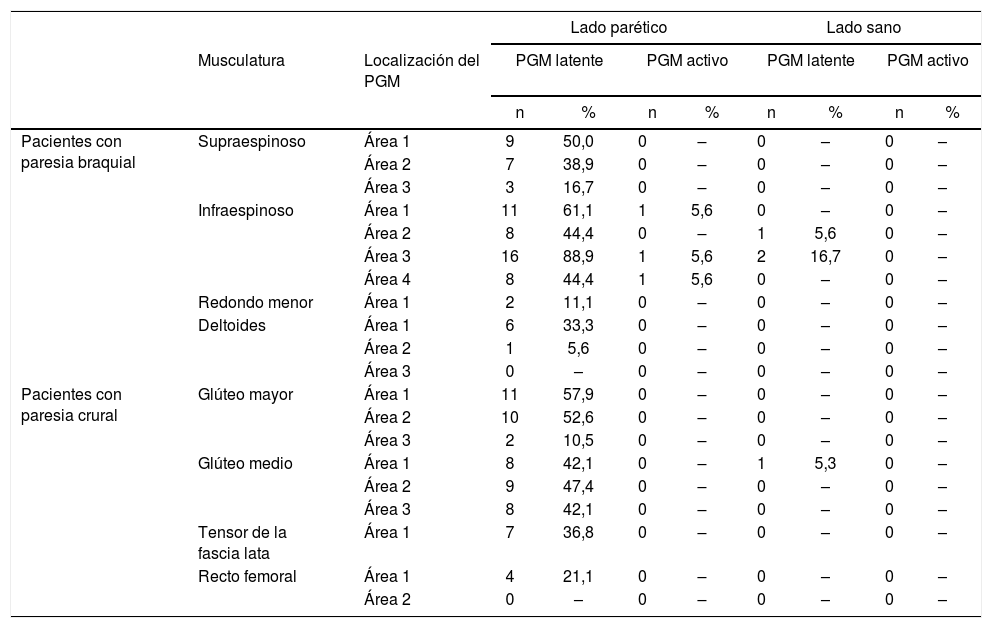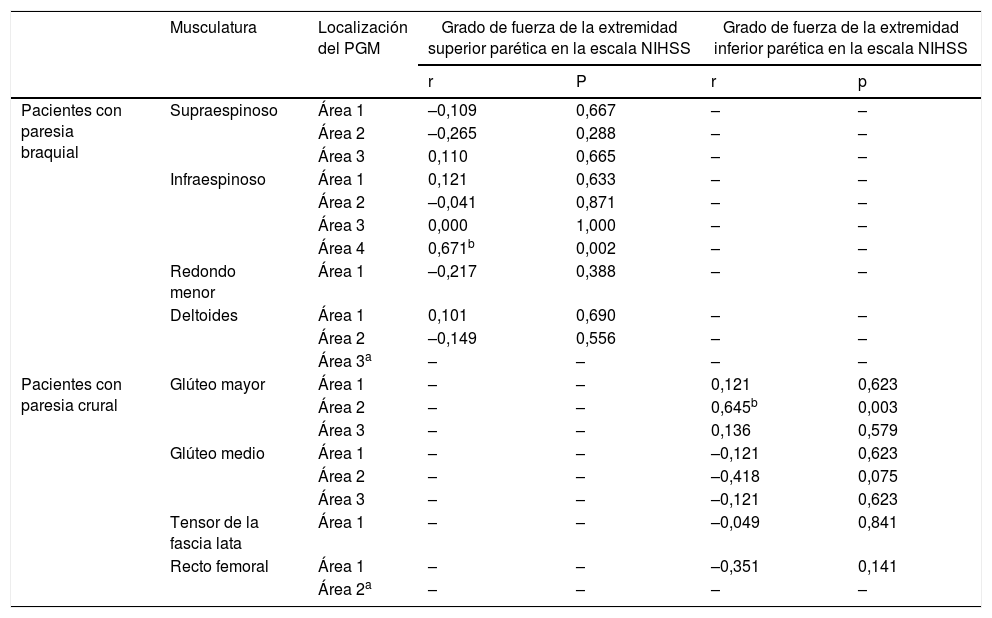Determinar la presencia de PGM activos y latentes en 4 músculos de hombro y 4 de cadera de las extremidades paréticas y no paréticas, en pacientes con ictus isquémico agudo, y analizar si existe relación con el grado de fuerza de las propias extremidades paréticas.
Participantes y métodosSe seleccionó a 22 pacientes con ictus isquémico de menos de 5 días de evolución, ingresados en la Unidad de Ictus de un centro hospitalario, que cursaron con una gravedad neurológica leve o moderada (escala National Institute of Health Stroke Scale 3-15) y paresia braquial o crural, y que, previamente al ingreso, presentaban autonomía funcional o incapacidad leve o muy leve (escala Rankin modificada 0-2). Se registraron los PGM en 4 músculos de fácil acceso palpatorio de cada hombro y 4 de cada cadera, siguiendo los criterios diagnósticos de Simons, Travell & Simons.
ResultadosTodos los pacientes mostraron PGM latentes en hombro y cadera paréticos, siendo más frecuentes en el infraespinoso (94,4%) y en el glúteo mayor (78,9%). El grado de fuerza de las extremidades paréticas se correlacionó con la presencia de PGM latentes en áreas concretas de ambos músculos.
ConclusionesLos resultados orientan hacia una elevada presencia de PGM, predominantemente latentes, en hombro y cadera de las extremidades paréticas secundarias al ictus isquémico agudo. A su vez, apuntan a la posible correlación entre la propia presencia de PGM latentes y el grado de fuerza de las mismas extremidades paréticas. Sin embargo, son necesarios estudios de mayor tamaño muestral que permitan corroborar lo hallado en el presente estudio piloto.
To determine the presence of active and latent MTrPs in 4 shoulder muscles and 4 hip muscles of the paretic and non-paretic limbs, in patients with acute ischaemic stroke, and to analyse if there is a relationship with the degree of strength of the paretic extremities.
Patients and methods22 patients with ischaemic stroke of less than 5 days’ evolution were selected, admitted to the Stroke Unit of a hospital centre with mild or moderate neurological severity (National Institute of Health Stroke Scale 3-15), brachial and / or leg paresis, and that prior to admission presented functional autonomy or mild or very mild disability (modified Rankin scale 0-2). The MTrPs were recorded in 4 muscles of easy palpable access of each shoulder and 4 of each hip, following the diagnostic criteria of Simons, Travell & Simons.
ResultsAll the patients showed latent MTrPs in the shoulder and hip pads, being more frequent in the infraspinatus (94.4%) and in the gluteus maximus (78.9%). The degree of strength of the paretic limbs correlated with the presence of latent PGMs in specific areas of both muscles.
ConclusionsThe results point towards a high presence of MTrPs, predominantly latent, in the shoulder and hip of the paretic limbs secondary to acute ischaemic stroke. In turn, they suggest a possible correlation between the presence of latent MTrPs and the degree of strength of the same paretic limbs. However, studies of larger sample size are needed to corroborate what was found in this pilot study.
Artículo
Si ya tiene sus datos de acceso, clique aquí.
Si olvidó su clave de acceso puede recuperarla clicando aquí y seleccionando la opción "He olvidado mi contraseña".Comprando el artículo el PDF del mismo podrá ser descargado
Precio 19,34 €
Comprar ahora













